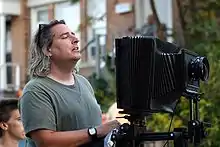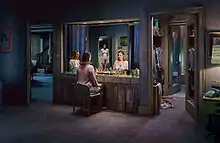Gregory Crewdson
Gregory Crewdson (born September 26, 1962) is an American photographer.[1] He photographs tableaux[2] of American homes and neighborhoods.
Gregory Crewdson | |
|---|---|
 Crewdson on location in Pittsfield, MA July 25, 2007 | |
| Born | September 26, 1962 Brooklyn, New York |
| Education | Brooklyn Friends; John Dewey High School; SUNY Purchase, BA, 1985; Yale University, MFA, 1988 |
| Occupation | Fine-art photographer, landscape photographer, professor |
| Employer | Yale University School of Art |
| Agent | Gagosian Gallery |
| Style | American realist landscape photography |
| Board member of | MASS MoCA |
| Awards | Skowhegan Medal for Photography, National Endowment for the Arts Visual Artists Fellowship |
| Website | www |
Life and career

Crewdson was born in the Park Slope neighborhood of Brooklyn, New York. He attended John Dewey High School, graduating early.
As a teenager, he was part of a punk rock group called The Speedies that hit the New York scene. Their song, "Let Me Take Your Photo" proved to be prophetic to Crewdson's future career. In 2005, Hewlett Packard used the song in advertisements to promote its digital cameras.
At Purchase College, State University of New York, he began experimenting with photography, not yet taking it seriously, Crewdson only saw it as a creative outlet and hobby. Gaining school recognition and a growing interest for art, he graduated undergraduate from SUNY Purchase and later attended Yale University receiving his Master of Fine Arts. His senior thesis embodied everyday life through portraiture of Lee, Massachusetts residents, the same location that later inspired his first series Natural Wonder from 1992 to 1997. He has taught at Sarah Lawrence, Cooper Union, Vassar College, and Yale University, where he has been on the faculty since 1993. He is now a professor at the Yale University School of Art.[3][4] In 2012, he was the subject of the feature documentary film Gregory Crewdson: Brief Encounters.[5] The film series followed the construction and the behind-the-scenes explanation from Crewdson himself of his thought process and vision for his pieces of his collection Beneath the Roses.
Crewdson is represented by Gagosian Gallery worldwide and by White Cube Gallery in London.[6]
Crewdson has been awarded the Skowhegan Medal for Photography [7] and a National Endowment for the Arts fellowship. His work has been shown at the Metropolitan Museum of Art, Whitney Museum of American Art, and the Brooklyn Museum.
Style

Crewdson's photographs usually take place in small-town America, but are dramatic and cinematic.[8] They feature often disturbing, surreal events. His photographs are elaborately staged and lit using crews familiar with motion picture production and lighting large scenes using motion picture film equipment and techniques.[9] He has cited the films Vertigo, The Night of the Hunter, Close Encounters of the Third Kind, Blue Velvet, and Safe as having influenced his style,[10] as well as the painter Edward Hopper[11] and photographer Diane Arbus.[12]
Crewdson's photography became a convoluted mix between his formal photography education and his experimentation with the ethereal perspective of life and death, a transcending mix of lively pigmentation and morbid details within a traditional suburbia setting. Crewdson was unknowingly in the making of the Pleasures and Terrors of Domestic Comfort exhibition of the Museum of Modern Art, earning him a following both from his previous educators and what would become his future agents and promoters of his work. The grotesque yet beautifully created scenes were just the beginning of Crewdson's work, all affected with the same narrative mystery he was so inspired by in his childhood and keen eye for the surreal within the regular. Fireflies, has become a standout amongst his collections known for their heightened emotion and drama compared to its simplicity of color and spontaneity. the exploration of form within his own work was evident within his transformation of how the photo was taken rather than just focusing on the subject.
The creation of the self defined American realist landscape photographer and his peculiar style originates from Crewdson's long appreciation for 20th century melodramas and literature, specifically Hitchcock and Ralph Waldo Emerson. These films drove Crewdson to challenge the essence of light and force it in a new direction in Twilight, a dramatic, highly pigmented collection of images that channel dusk to the subject of the photograph. Crewdson wanted to focus even more heavily on the suburban lifestyle that is the focus of his main movie inspirations. Known for their methodical yet rhythmic use of language, Hitchcock and Emerson developed a new challenge for Crewdson by changing language to visuals in the most effective way. The look of sadness and contemplation on the subjects faces was something most major galleries had never seen, intentional sadness yet in such a bland and unexpected way. Similarly, Dream House captures the same "moment between moment" of thought from the subject from creative angles and cryptic perspectives.
Gregory Crewdson's most recognized and iconic collection is Beneath the Roses, similar to his previous projects, its haunted urgency and profound dislocation from the audience is uncomfortable yet familiar. Branching off of his previous collections, Beneath the Roses was aimed to capture cinematic production in the stillness of one picture. With a budget similar to that of a small movie production, each image involved hundreds of people and weeks to months of planning. Crewdson's interventions into the streets of typical American suburbia became a nuance interpretation of reality of lifestyle focusing on the most dramatic emotions and complex moments of silence and thought for the subject.
Crewdson explored the idea of challenging tradition with experimentation of his title outside of the U.S. at the abandoned Cinecittá studios outside of Rome. Known for its mysterious stillness and emptied character, the set was new to Crewdson's typical use of subject and storyline but reflected the same balance and organic nature of a created set turned into an art piece. The simplicity of Sanctuary’s development contrasts Gregory's tendency for detail and specificity evoking a more compelling landscape that was already created for him and caught the attention of White Cube, Crewdson's European agent in London. By converting these cinematic scenes into ordinary life, he explores a new and unfamiliar genre of his own focused on naturalizing a manmade scenario in a world already based on the artifice of American lifestyles.
After years of exploring the idea of cinematic photography, Sanctuary was Crewdson's return to photography, his original hobby and technical training. Most recently, Crewdson has created Cathedral of the Pines, similar to Beneath the Roses and Twilight, a distanced interpretation of exaggerated drama by an intervention into natural in its most synergetic state. The collection was shown at Gagosian Gallery in New York City. The collection returns to his early photographic origins in Becket, Massachusetts set deep in the woods far from familiarity of subject and setting.
Exhibitions
- Yale University Art Gallery, New Haven, CT, 1988
- BlumHelman Warehouse, New York; and traveled to Portland School of Art, Portland, Maine; Ruth Bloom Gallery, Los Angeles, CA, 1991
- Houston Center for Photography, Houston, TX, 1992
- Feigen Gallery, Chicago, IL, 1993
- Palm Beach Community College Museum of Art, Palm Beach, FL, 1994
- Galleri Charlotte Lund, Stockholm, Sweden, 1995
- Les Images du Plaisir, Frac des Pays de la Loire, Galerie des Carmes, La Flèche, France, 1995
- Jay Jopling / White Cube, London, 1995
- Ginza Artspace, Shiseido Co., Tokyo, 1996
- Cleveland Center for Contemporary Art, Cleveland, OH, 1997
- Espacio Uno, Museo Nacional Centro de Arte Reina Sofía, Madrid, Spain, 1998; and traveled to Salamanca, 1999
- Rudofinium Gallery, Prague, Czech Republic, 2008
- Duane Hanson/Gregory Crewdson: Uncanny realities, Museum Frieder Burda, Baden-Baden, Germany, 2010–2011
- Kulturhuset, Stockholm, Sweden, 2011
- Gregory Crewdson: In a Lonely Place, C/O Berlin, Berlin, 2011; and traveled to Det Kongelige Bibliotek, Copenhagen, Denmark, 2011/2012)[13][14]
- Cathedral of the Pines, Gagosian Gallery, New York, NY, 2016;[15] The Photographers' Gallery, London, 2017.[16]
- The Becket Pictures, FRAC Auvergne, Clermont-Ferrand, France, 2017.
Publications
- Hover. Artspace Books, 1995. ISBN 1891273000.
- Twilight: Photographs by Gregory Crewdson. Harry N. Abrams, 2003. ISBN 0810910039. With an essay by Rick Moody.
- Gregory Crewdson: 1985–2005. Hatje Cantz, 2005. ISBN 377571622X.
- Gregory Crewdson: Fireflies. Skarstedt Fine Art, 2007. ISBN 0970909055.
- Beneath the Roses. With Russell Banks. Harry N. Abrams, 2008. ISBN 978-0810993808.
- Sanctuary. With Anthony O. Scott. Hatje Cantz, 2010. ISBN 978-3775727341.
- In a Lonely Place. Hatje Cantz, 2011. ISBN 978-3775731362.
- Gregory Crewdson. New York: Rizzoli, 2013. ISBN 978-0847840915.
- Cathedral of the Pines. New York: Aperture, 2016. ISBN 978-1-597113-50-2. With a text by Alexander Nemerov.
References
- O'Hagan, Sean (June 20, 2017). "Cue mist! Gregory Crewdson, the photographer with a cast, a crew and a movie-sized budget". The Guardian. London. Retrieved June 30, 2017.
- Campany, David (2008). Photography and cinema. Reaktion Books. pp. 140–. ISBN 978-1-86189-351-2.
- Gregory Crewdson Biography. Rogallery.com. Retrieved November 17, 2011.
- Yale University School of Art: Gregory Crewdson. Art.yale.edu. Retrieved November 17, 2011.
- Shapiro, Ben. "Gregory Crewdson: Brief Encounters, official site". Ben Shapiro Productions. Retrieved February 13, 2012.
- Warren, Lynne (ed.) (2005). Encyclopedia of Twentieth-Century Photography. Routledge. ISBN 1-57958-393-8.CS1 maint: extra text: authors list (link)
- Skowhegan Awards Honorees. Retrieved September 20, 2020.
- Kitamura, Katie. "Gregory Crewdson". frieze. Archived from the original on May 14, 2011. Retrieved March 19, 2011.
- "Gregory Crewdson". V&A. Archived from the original on April 16, 2010. Retrieved March 19, 2011.
- "Five in Focus: Gregory Crewdson's Five Favorite Films". Focus Features. Archived from the original on April 18, 2011. Retrieved March 19, 2011.
- Gregory, Crewdson. "Aesthetics of Alienation". Tate Etc. Archived from the original on June 8, 2011. Retrieved March 19, 2011.
- "Gregory Crewdson". White Cube. Retrieved March 19, 2011.
- ""Gregory Crewdson: In a Lonely Place" at Det Kongelige bibliotek". Archived from the original on December 19, 2011. Retrieved December 28, 2011.
- ""Gregory Crewdson: In a Lonely Place" at C/O Berlin". Retrieved August 23, 2011.
- "Gregory Crewdson: Cathedral of the Pines". Gagosian Gallery.
- "Gregory Crewdson: Cathedral of the Pines". The Photographers' Gallery.
